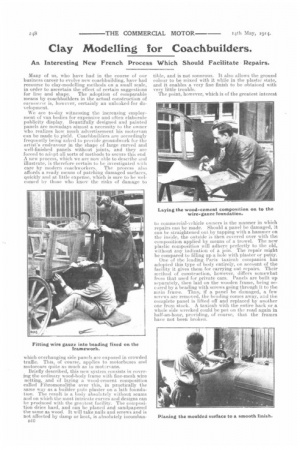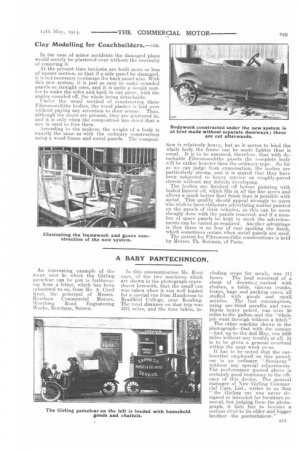Clay Modelling for Coachbuilders.
Page 4

Page 5

If you've noticed an error in this article please click here to report it so we can fix it.
An Interesting New French Process Which Should Facilitate Repairs.
Many of us, who have had in the course of our business career to evolve new coaehbuilding, have had recourse to clay-modelling methods on a small scale, in order to ascertain the effect of certain suggestions for line and shape. The adoption of comparable means by coaehbuilders in the actual construction of caros80.ie is, however, certainly an unlooked-for development.
We are to-day witnessing the increasing employment of van bodies for expensive and often elaborate publicity display. Beautifully designed and painted panels are nowadays almost a necessity to the owner who realizes how much advertisement his motorvan can be made to yield. Coachbuiklers are accordingly frequently being asked to provide groundwork for the artist's endeavour in the shape of large curved and well-finished panels without joints, and they are forced to adept all sorts of methods to secure this end A new process, which we are now able to describe and illustrate, is therefore certain to be investigated wiih care by modern eoachworkers. The process also affords a ready means of patching damaged surfaces, quickly and at little expense, which is sure to be welcomed by those who know the risks of damage to
which overhanging side panels are exposed in crowded traffic. This, of course, applies to motorbuses and motorcars quite as much as to motervans.
Briefly described, this new system consists in covering the oetlinary wood-body frame with fine-mesh wire netting, and of laying a wood-cement composition called Fibromonolithe over this, in practically the same way as a builder puts plaster on a lath foundation. The result is a body absolutely without seams and on which the most intricate curves and designs can he produced with the greatest facility. The composition dries hand, and can be planed and sandpapered the same as wood. It will take nails and screws and is not affected by damp or heat, is absolutely incombus al 0 tilde, and is not sonorous. it also allows the ground colour to be mixed with it while in the plastic state, and it enables a very fine finish to be obtained with very little trouble.
The point, however, which is of the greatest interest to commercial-vehicle owners is the manner in which repairs can be made. Should a panel be damaged, It can be straightened out by tapping with a hamnier on the inside, the outside is then covered over with the composition applied by means of a trowel. The new plastic composition will adhere perfectly to the old, without any indication of a join. The repair might be compared to filling up a hole with plaster or putty.
One of the leading Paris taxicab companies has adopted this type of body entirely, on account of the facility it gives them for carrying out repairs. Their method of construction, however, differs somewhat from that used for private cars. Panels are built up separately, then laid on the wooden frame, being secured by a beading with screws going through it to the main frame. Thus, if a panel be damaged, a few screws are removed, the beading conies away, and the complete panel is lifted off and replaced by another one from stock. A taxicab with the entire back or a whole side wrecked could be put on the road again in half-an-hour, providing, of coarse, that the frames have not been broken.
In the case of minor accidents the damaged place would merely be plastered over without the necessity of removing it.
At the present time taxicabs are built more or less of square section, so that if a side panel be damaged, it is not necessary to,change the back panel also. With this new system, it is just as easy to make rounded panels as straight ones, and it is quite a simple matter to make the sides and back in one piece, with the angles rounded off, the whole being detachable. Under the usual method of constructing these Fibromonolithe bodies, the wood plaster is laid over without paying any attention to door seams. Thus, although the doors are present, they are plastered in, and it is only when the composition has dried that a saw is used to free them.
According to the makers, the weight of a body is exactly the same as with the ordinary construction using a wood frame and metal panels. The composi tion is relatively heavy, but as it serves to bind the whole body the frame can be made lighter than is usual. It is to be assumed, therefore, that with detachable Fibroinonolithe panels the complete body will be rather heavier than the ordinary type. So far as we can judge from examination, the bodies are particularly strong, and it is stated that they have been subjected to heavy service on roughly-paved streets without any defects developing.
The bodies are finished off before painting with boiled linseed oil, which fills in all the fine pores and allows a much better final finish than is possible with metal.. This quality should appeal strongly to users who wish to have elaborate advertising matter painted on the panels of their vehicles, as this can be more cheaply done with the panels removed, and if a number of spare panels be kept in stock the advertisements can be varied as required. Another advantage is that there is no fear of rust spoiling the finish, which sometimes occurs when metal panels are used. The patent for Fibromonolithe constructions is held by Messrs. Th. Butiaux, of Paris.


























